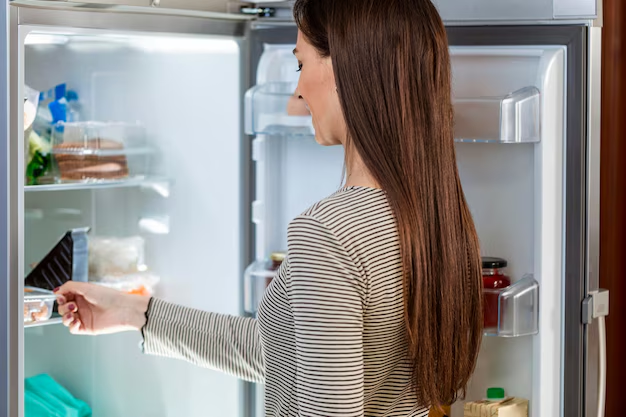How Often Should Your Refrigerator Cycle On and Off to Keep Cool?
A refrigerator is an indispensable appliance in most homes, crucially tasked with keeping our food fresh and preventing spoilage. But have you ever wondered how often it should cycle on and off? If so, you're in the right place. This comprehensive guide dives into the mechanics of refrigerator cycling, why it's important, and what you can do if your fridge behaves oddly. Whether you're noticing unusual activity from your appliance or are just curious, this information will empower you to ensure optimal performance and longevity from your refrigerator.
🤔 What Does "Cycling On and Off" Mean?
Refrigerators operate by cycling on (when the compressor runs) and off to maintain the set internal temperature. This cycle is crucial to ensure that the food stays fresh without unnecessarily straining the appliance.
The Role of the Compressor
The compressor is the heart of a refrigerator. It compresses the refrigerant and drives it through the coils, facilitating the heat exchange process that ultimately keeps your fridge cold. When the compressor is on, the refrigerator is actively cooling. It switches off when the desired temperature is reached, marking the off cycle.
Why Cycling Is Necessary
- Energy Efficiency: Continuous running wastes energy and increases wear and tear.
- Temperature Maintenance: Cycling maintains consistent temperatures, protecting food quality.
- Longevity: Cycling allows periods of rest, which can extend the life of the refrigerator.
🔍 How Often Should a Refrigerator Cycle?
Now, let's delve into what might constitute a "normal" cycle. While it's hard to define an exact standard since it varies with multiple factors, understanding general patterns can be helpful.
Typical Cycling Patterns
- Average Time: A typical refrigerator cycle might last around 30 minutes to an hour, but this can vary.
- Frequency: Most refrigerators cycle about 4 to 8 times per day. However, factors such as room temperature, usage frequency, and the fridge's condition can influence these numbers.
Factors Influencing Cycling Frequency
- Ambient Temperature: In warmer environments, a refrigerator might cycle more frequently to maintain the desired temperature.
- Door Usage: Frequent opening and closing can cause the compressor to kick in more often.
- Ventilation Space: Limited airflow around the appliance can lead to inefficient cycling.
- Load and Organization: Overstuffed or poorly organized fridges can circulate air less efficiently, impacting cycling frequency.
🚨 Signs of Abnormal Cycling
Sometimes, a refrigerator's cycling behavior might indicate an underlying issue. Here's what to watch out for:
Issues to Monitor
- Constant Cycling: If your refrigerator rarely shuts off, it might be struggling to maintain the temperature.
- Infrequent Cycling: If it doesn't kick on even when the temperature rises, there might be a problem.
- Loud Noises: Unusual sounds during cycling can indicate mechanical issues.
Possible Causes of Abnormal Cycling
- Faulty Thermostat: Inaccurate temperature readings can lead to improper cycling.
- Damaged Door Seal: If seals are worn, air can leak, causing the refrigerator to work overtime.
- Dirty Coils: Dusty or blocked coils reduce efficiency, affecting cycling patterns.
- Low Refrigerant: Reduced refrigerant levels can hinder cooling, affecting how the compressor cycles.
🛠️ How to Troubleshoot and Improve Cycling
If you're experiencing issues or want to ensure your refrigerator runs optimally, there are several strategies you can employ.
DIY Tips to Enhance Refrigerator Function
- Regular Cleaning: Clean the coils and inside the fridge to promote efficient air circulation.
- Check Seals: Ensure door seals are intact and replace them if they appear worn.
- Manage Contents: Avoid overfilling and organize items for proper airflow.
- Monitor Temperature Settings: Ensure the thermostat is set correctly, usually around 37°F (3°C) for the refrigerator section.
When to Call a Professional
If DIY efforts don't resolve cycling issues, it may be time to consult a professional. Here are some situations where expert help is beneficial:
- Persistent cycling issues that DIY fixes don't address.
- Electrical issues that require professional assessment.
- Suspected refrigerant leaks or compressor problems.
📊 Quick Reference Summary
Here's a handy summary of practical tips and troubleshooting guidelines:
Optimal Cycling Insights
- 🕒 Average Cycle: 30 minutes to 1 hour
- 🔄 Frequency: 4 to 8 cycles per day
Troubleshooting Tips
- 🛠️ Clean Coils Regularly
- 🔍 Inspect Door Seals for Air Leaks
- 📐 Organize Items for Better Airflow
- 🌡️ Maintain Proper Temperature Setting
When to Seek Help
- 🔧 Persistent Cycling Issues
- 🔌 Electrical Concerns
- 💧 Possible Refrigerant Leaks
🌟 The Bottom Line on Refrigerator Cycling
Understanding how your refrigerator should cycle can be crucial for maintaining its efficiency and lifespan. While general patterns exist, acknowledging the role of environmental conditions, usage habits, and appliance health can make a significant difference. Whether your fridge is in top shape or showing signs of distress, knowing when to act can save time, money, and resources.
Refrigerators are an investment, and like all investments, attentive care maximizes benefits. Keep an eye on how often it cycles on and off, remain vigilant for any irregularities, and don't hesitate to call in the professionals when needed. Keeping your refrigerator in tip-top shape ensures not only energy efficiency but also the freshness and safety of your stored food goods. Happy fridge monitoring!
